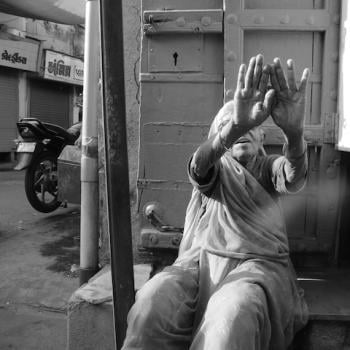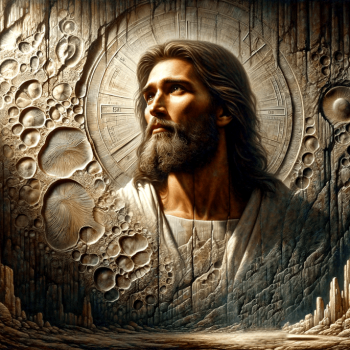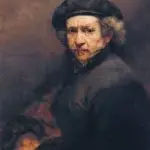 I am continually amazed how truly timeless literature can appeal to us in different phases of our lives; a given work remains the same, but it resonates differently with us as we grow and evolve, and we see new lessons and gain new understandings from it as our own lives transform. On such work that has influenced me in such a way is Alfred, Lord Tennyson’s “The Lady of Shalott,” a narrative poem written in 1842 that tells the story of a “fairy” lady who lives all alone on an island not far from King Arthur’s Camelot. She eternally weaves a “web,” or tapestry that captures scenes she sees reflected in a mirror, scenes of travelers passing by on their way to Arthur’s city. She is forbidden to actually look “down to Camelot,” lest she suffer the consequences of an unknown “curse.” At first she is content to weave into her tapestry the images of the simple people passing by on the road, but when a young, recently married couple pass by, she admits she has grown “half sick of shadows.” One day, she sees Arthur’s champion Lancelot ride by in full knightly regalia, and everything changes. Let’s explore this poem and its timelessness as an example of how truly transcendent art can influence us for decades, providing new insights as we age. First, I would recommend reading the poem, and even listening to the excellent musical rendition performed by Canadian musician Loreena McKennitt as you read along (come back when you’re ready). There. Wasn’t that great? Now we can delve into this masterwork and see what it has to offer us.
I am continually amazed how truly timeless literature can appeal to us in different phases of our lives; a given work remains the same, but it resonates differently with us as we grow and evolve, and we see new lessons and gain new understandings from it as our own lives transform. On such work that has influenced me in such a way is Alfred, Lord Tennyson’s “The Lady of Shalott,” a narrative poem written in 1842 that tells the story of a “fairy” lady who lives all alone on an island not far from King Arthur’s Camelot. She eternally weaves a “web,” or tapestry that captures scenes she sees reflected in a mirror, scenes of travelers passing by on their way to Arthur’s city. She is forbidden to actually look “down to Camelot,” lest she suffer the consequences of an unknown “curse.” At first she is content to weave into her tapestry the images of the simple people passing by on the road, but when a young, recently married couple pass by, she admits she has grown “half sick of shadows.” One day, she sees Arthur’s champion Lancelot ride by in full knightly regalia, and everything changes. Let’s explore this poem and its timelessness as an example of how truly transcendent art can influence us for decades, providing new insights as we age. First, I would recommend reading the poem, and even listening to the excellent musical rendition performed by Canadian musician Loreena McKennitt as you read along (come back when you’re ready). There. Wasn’t that great? Now we can delve into this masterwork and see what it has to offer us.
The opening stanzas orient us to the setting, offering almost a “skycam” view of the countryside surrounding Arthur’s great capitol city. The scene hones in on “the island of Shalott,” where lives a solitary woman who is something of an urban legend. Few have seen her, but she has been heard singing by the reapers who harvest Camelot’s crops. In fact, they are the only ones who can hear her. That is one of the first observations from the poem that has always intrigued me. Why only the early-morning reapers? Why cannot the many travelers moving to and from Camelot every day hear her songs as well? Perhaps their more intimate connection to the land enables them to possess this special privilege; to hear the music of the lady. One reaper in the poem hears her song and whispers, “ ‘Tis the fairy Lady of Shalott” (Tennyson lines 35-36). This is one of only four lines of dialogue in the entire poem, so it can’t lack significance. I have always viewed the lady as an artist—she sings, she weaves to create a beautiful tapestry—and perhaps those traveling to Camelot simply have no time for such trivial things as art. They cannot appreciate it, and so do not even notice it. Those who live more slowly, the reapers, who resonate with the natural rhythms of the Earth itself (Spiritual Naturalists, perhaps?), know she is there. There is one of the poem’s first lessons for us. We need to slow down and take more time to appreciate the beautiful things in life that are all around us. Too often we just surge ahead, too caught up in the frenetic pace of modern life to pause, focus, and truly listen to the Earth’s “music.” Perhaps if we did, much of the stress and anxiety produced by the world we have allowed to surround and consume us might start to lose its hold on us.
In Part II, we learn a little more about the lady and the “curse” that is on her. In truth, we are told only what she herself knows, which isn’t much. She weaves constantly on her tapestry, with a “whisper” having told her if she stops weaving and “looks down to Camelot,” that curse will be unleashed. She isn’t sure what exactly the curse is or what it will do to her, but she knows it isn’t good, so she remains content to just keep weaving along as she watches images reflected in her mirror and integrates them into her tapestry. Village “churls,” market girls, an abbot, a shepherd, a page, and every now and then a knight or two. It’s the knights that sting her a little. She doesn’t have one, we are told, and we can infer that she might not mind that at all.
She witnesses a funeral procession pass by with lights and singing. Not really aware of the ceremony’s meaning, she just weaves it into the ever-growing chronicle of human activity that is her sole occupation. Then, by the light of the moon, she sees a newlywed couple walking by on the road, inciting one of only two lines of dialogue she has in the entire poem: “I am half sick of shadows” (Tennyson line 71). Aren’t we all half sick of shadows right now? We’ve been cooped up in our homes for two years, forced to entertain ourselves with screens and “shadows” of reality via the streaming service of choice, not to mention the endless Zoom calls that have become such a ubiquitous part of our realities. We long for human connection, just as the lady does. She dreads pursuing it, fearing an unknown curse that hovers over her should she dare to actually try and change her monotonous reality. We too have had an unseen menace hovering all about us, threatening to sicken or potentially kill us should we risk exposure to it. Prior to COVID’s emergence, I also saw this “curse” manifesting as a lack of confidence to pursue what was deeply desired in life. We fear taking risks to pursue greater ambitions, as such pursuits risk disrupting the status quo with which we have grown comfortable. The unknown is and has always been a source of fear. If you never risk anything, you’ll never feel the disappointment that accompanies failure—you’ll also never truly live, and end up much later in life wondering what might have been when it is too late to do anything about it. That, to me, is what is to be most feared.
Well, curse or no, she keeps on weaving until HE passes through the mirror one day: Lancelot, first among Arthur’s knights. 36 lines of the poem are devoted just to him and his appearance (where very little of the lady’s appearance is ever described). He’s glorious. The jewels embedded in the leather of his saddle, his brilliant helmet plume—he’s compared to a meteor blazing through the night sky. He has “coal black curls” (110) flowing out from under his helmet, and his “broad clear brow” (108) glows in the sunlight. There is so much visual imagery devoted to him; he’s real, substantive—not a shadow. The lady can’t stand it—time to take a risk: “She left the web, the left the loom,/She made three paces thro’ the room,” (117-18). Before she has a chance to even think what she is doing, the mirror “cracks from side to side,” and her second and final line of dialogue is related to us: “The curse is come upon me” (124). She knows how much trouble she is in, and she also knows she has no time to waste. This is a lesson we all need to take to heart, though it comes easier to those of us who have seen more winters than others. We can’t live as though we have a thousand years ahead of us, continuing to say “Maybe tomorrow I’ll get to that.” Every year of my childhood my dad would say he wanted to visit the Buffalo Bill Museum in Cody, Wyoming. Did he ever do that? No. He’s 90 now and can barely walk. Does he lay in bed, staring at the ceiling, regretting never having made that longed-for trip, or pursuing any other unspoken dreams he had? I hope not, but I fear he might, and it saddens me. Do you have dreams you haven’t pursued due to the potential risk involved? Will you be able to bear the weight of the “If only…” thoughts that wait for you like the invisible chains that Ebenezer Scrooge couldn’t see but grew longer every day of his misled life? Let’s see what the lady’s risk brings her.
Well, it isn’t good, and doesn’t do much to encourage readers to stand up to their “curses.” She finds a boat moored to the island (whose was that?), writes her name on the prow, and launches it out into the river. The current takes her downstream toward Camelot, but as she drifts, her body grows cold, her blood freezes, her eyes darken, and signing one last song, she dies before reaching the city. So what did she get for chasing her dreams? A cold and lonely death. She does reach Camelot (at least her body does), and the court of the castle come running out to see the “fairy lady,” her body still glowing in the boat which has drifted right up to Camelot’s wharf. The courtiers “cross themselves for fear” in an effort to protect themselves from the pagan fairy. Only Lancelot himself shows no fear, walking right up to take a good look at her before offering the final lines of the poem: “She has a lovely face;/God in his mercy lend her grace,/The Lady of Shalott (169-71). If only she had been able to even just see him looking at her, or hear him offer that blessing. But that’s not always how it works. Sometimes dreams don’t come true, no matter how much we want them to. She clearly made an impression on Lancelot there at the end, and who knows what kind of lasting effect she might have had on him? Perhaps the journey was not completely without fruit, but Tennyson leaves that up to us to speculate about. By Excalibur, I love that poem.
So does the Lady’s death symbolically tell us that chasing our dreams can only end in defeat and disappointment? I don’t choose to look at it that way. She was an artist, committed to a specific way of life. She chose to abandon her art and try to be a part of a world that just wasn’t hers, and it destroyed her. We should take her fate as a cautionary tale not to abandon the dream we already have in pursuit of “shadows.” Lancelot was real, but having him for herself was a shadow, something that was never meant for her in the first place. She had her art, her connection to the natural world, but allowed the glitz and glamour of modernity to tempt her with its wiles. She belonged to an older, more grounded world with deep roots and an ancient heritage, and the seductive “curse” of the new managed to convince her to turn her back on all that and chase after the falsity of the shadow. Her art was her love; true, the artist’s path can be a lonely one, and I speak from experience on that, but to forsake a skill set you have been building for years and drawing enjoyment from just to jump on the modern bandwagon and chase after shadows can only end in losing both the life you loved and ultimately discovering you were misled. The artist died, realizing Lancelot’s world could never be hers—or did she even realize it before it killed her? There is no real indication that she did; she sang up until the very end, trying to comfort herself and keep herself going as long as she could. To all you artists out there: never give up on what you love doing; don’t be tempted to just abandon it and get sucked into the ubiquitous distractions that can become addictive, mind-numbing hindrances to you accomplishing something of genuine worth that will one day bring joy and appreciation to others. Your soul won’t be able to stand it—as the Lady’s ultimately couldn’t. Remember that Lancelot, looking down on a fairy that evoked fear in everyone else (misunderstood artist, anyone?) found her lovely. There will be those who find what you have to offer the world lovely. Don’t stop. Whatever shape your art takes, be it writing, singing, playing an instrument, drawing, painting, sculpting—stay at it and love it, because the world today needs it as much as you do.
Tennyson saw the way the wind was blowing in his time. He saw more and more people abandoning the English countryside and moving to the cities, forsaking their ancestral homelands and turning toward what they thought would be new and better opportunities in urban centers, another theme the poem addresses. Life was changing forever, and he lamented that. I lament it too. I do not like many aspects of what we have become. There are modern wonders to be sure, and we have much to be thankful for when it comes to medical advances and ongoing scientific advancements that, if given the chance, will possibly enhance our lives in ways we can only begin to imagine. If given the chance. We are also growing less literate, more polarized, increasingly apathetic, and turning our backs on older, tried and true methods of being in exchange for the empty shadows of the bread and circuses of today. Find your art. Revel in it, whatever shape it takes. Beautify the world. Remember the Lady and her many lessons.
So yes, pursue your dreams with relentless passion, but don’t allow the shadows to confuse you as they did the Lady, leading you down the freezing river toward a world where you don’t belong. Listen to your heart and spirit and keep working to bring lovely things into the world, laboring night and day. Thank you once again, Mr. Tennyson.
Subscribe to The Spiritual Naturalist Society
Learn about Membership in the Spiritual Naturalist Society
The Spiritual Naturalist Society works to spread awareness of spiritual naturalism as a way of life, develop its thought and practice, and help bring together like-minded practitioners in fellowship.
SNS strives to include diverse voices within the spectrum of naturalistic spirituality. Authors will vary in their opinions, terms, and outlook. The views of no single author therefore necessarily reflect those of all Spiritual Naturalists or of SNS.
__________
Work cited:
Tennyson, Alfred. “The Lady of Shalott.” https://www.poetryfoundation.org/poems/45360/the- lady-of-shalott-1842. Accessed 11 March 2022
















